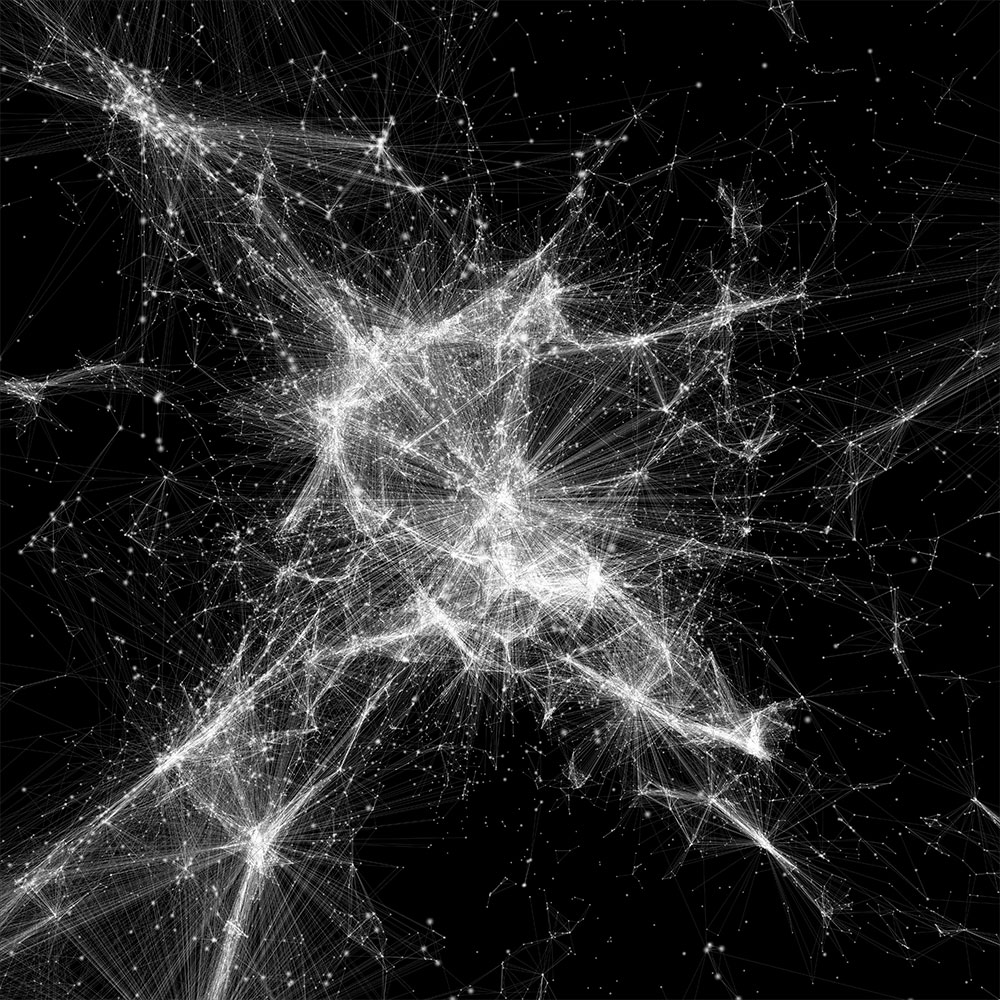ART-PRESENTATION: BarabásiLab-Hidden Patterns, Network Thinking
 More data are produced now every day than before in an entire decade. To cope with this volume of data a new science is needed: the visualization of identifying nodes and networks, of parameters and patterns. The exhibition “BarabásiLab: Hidden Patterns. Network Thinking” invites visitors to discover the invisible data structures that have now been visualized by the physicist and network scientist Albert-László Barabási and his research laboratory.
More data are produced now every day than before in an entire decade. To cope with this volume of data a new science is needed: the visualization of identifying nodes and networks, of parameters and patterns. The exhibition “BarabásiLab: Hidden Patterns. Network Thinking” invites visitors to discover the invisible data structures that have now been visualized by the physicist and network scientist Albert-László Barabási and his research laboratory.
By Dimitris Lempesis
Photo: ZKM Archive
The exhibition “BarabásiLab: Hidden Patterns. Network Thinking” presents the work of Hungarian physicist and network scientist Albert-László Barabási and his research laboratory at Northeastern University in Boston, USA. Over the past 25 years BarabásiLab has developed a vocabulary for complexity based largely on forms of expression taken from art. The innovative and interdisciplinary field of network research enables various cultural and social phenomena to be analyzed by visualizing invisible, concealed, connections and repeating patterns in nature, society, and culture. Network science is used, for example, in medicine, pharmacy, and physics as well as to research infrastructures, social systems, and development processes. The exhibition is the first opportunity to get an overview of BarabásiLab’s work in Germany and the forms of visualization they have developed; the product of a collaborative endeavor involving scientists, artists, and designers. Far from imposing a reductionist framework on our complex world, the works produced by BarabásiLab reveal the hidden patterns in complex systems that determine our biological and social existence. “Nature 150” (2019): In 2019 Albert-László Barabási was commissioned to design the cover for the 150th anniversary issue of the science magazine “Nature”. For this the BarabásiLab mapped out the network of citations for all 88,000 articles the magazine had published since 1900. On the map, two papers are linked if scientific publications have cited both of them, capturing the largely hidden perception of connectedness in the eye of the scientific community. As the colors mark different disciplines, the network reveals the highly multidisciplinary scope of the journal and illuminates how various disciplines relate to each other. “Art Network” (2018–19): In 2016, the BarabásiLab began applying the tools of network and data science to the art world. A massive number of data points about the exhibition history of half a million artists in galleries and museums worldwide enabled the Lab to unveil the invisible connections behind institutions, and the impact of this network on artists’ careers. In »The Art Network«, two institutions—a museum and a gallery, for example—are connected if an artist has shown their work in both institutions. The map captures the largely invisible network between thousands of art institutions and shows the interconnectivity between institutions based on their governance. The BarabásiLab used the tax data filed by all art institutions in the US to identify the respective boards of directors. The network’s nodes are museums and art-related nonprofit organizations, connected if they share a board member. “Cosmic Web” (2016): With this project, the BarabásiLab aimed to deepen our perspective on the origins of the cosmic web. To construct its map, the team used data on 24,000 galaxies, provided by a cosmological simulation that traces the evolution of all galaxies since the Big Bang. It then tested multiple types of links to connect individual galaxies, capturing dependencies grounded in physics and cosmology. “Human Mobility” (2008–20): The various visualizations presented here on the topic of human mobility are based on data collected by mobile-phone network providers and the analysis of tweets on Twitter. The works capture the spatial and temporal movement patterns of people and how these have changed due to the effects of the COVID-19 pandemic. They also reveal the predictability of everyday human behavioral and communication patterns. As these mobility and communication networks also facilitate spreading, the works illustrate transmission patterns taken up by viruses and fake news. The first scientific paper by BarabásiLab on mobility appeared on the front page of the journal Nature on 5/6/2008, under the title “Understanding Individual Human Mobility Patterns”. The research relied on data collected by a European mobile-phone company to record the physical locations and time histories of individual mobile-phone users. The visualizations show examples of individual movements over time, allowing geographic movements to be retraced by stringing together real-time locations. The data also shows the exceptional predictability of daily routines: through algorithmic analysis of the anonymized data sets, BarabásiLab could predict a person’s future location with 93 percent accuracy.
Current members of BarabásiLab: Albert-László Barabási, Sara Benedetti, Csaba Both, Ayan Chatterjee, Szu Yu Chen, Amar Dhand, Xiao Gan, Alexander Gates, Alice Grishchenko, Deisy Gysi, Rachael Leary, Charles Levine, Yanchen Liu, Yang-Yu Liu, Enrico Maiorino, Giulia Menichetti, Shany Ofaim, Ben Piazza, Babak Ravandi, Peter Ruppert, Hiroki Sayama, Michael Sebek, Louis Shekhtman, James Stanfill, Kishore Vasan, Xindi Wang and Ursula Widocki.
Photo: BarabásiLab, Fake News, 2018, © BarabásiLab (Albert-László Barabási, Mauro Martino, Nima Dehmami, Onur Varol)
Info: Curators: Peter Weibel with Clara Runge, ZKM|Center for Art and Media, Lorenzstraße 19, Karlsruhe, Germany, Duration: 1/5/2021-16/1/2022, Days & Hours: Wed-Fri 10:00-18:00, Sat-Sun 11:00-18:00, https://zkm.de


Right: BarabásiLab, Interactum, 2012, © BarabásiLab



